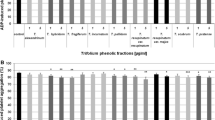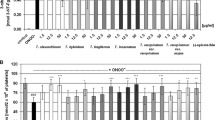Abstract
This study aimed to determine the effect of lyophilized aqueous extracts of Scutia buxifolia on NTPDase and 5′-nucleotidase activity on platelets and lymphocytes as well as the profile of the platelet aggregation. In vitro tests were used to investigate the effect of the aqueous crude extract obtained from S. buxifolia leaves (SbL) and stem bark (SbS) on enzymatic activities and platelet aggregation. The platelets and lymphocytes were exposed to lyophilized aqueous extracts of S. buxifolia at concentrations of 1–200 μg/mL in the presence of ATP, ADP, AMP as substrates, during the enzymatic assay, as well as the platelet aggregation. The results showed that SbS and SbL potently inhibited NTPDase and 5′-nucleotidase in platelets and lymphocytes. ADP-induced aggregation was inhibited by the SbS (50, 100, and 200 μg/mL) and SbL (200 μg/mL). In addition, these results suggest that S. buxifolia have compounds, such as gallic acid, chlorogenic acid, caffeic acid, quercetin, rutin, and kaempferol, which cause a decrease the NTPDase and 5′-nucleotidase activity, resulting in alterations in adenine nucleotide levels and protection against ADP-induced platelet aggregation.




Similar content being viewed by others
References
World Health Organization (WHO) (2008) Regulatory situation of herbal medicines: a worldwide review. WHO, Geneva, p 45
Agra MF, Freitas PF, Barbosa-Filho JM (2007) Synopsis of the plants known as medicinal and poisonous in Northeast of Brazil. Rev Bras Farmacogn 17:114–140
Silva C, Souza J, Mota V, Pereira M, Silva S (2009) Antimicrobial activity of crude extract of Brazilian tree leaves against Staphylococcus aureus. New Biotechnol 25:S7
De Bona KS, Bellé LB, Sari MH, Thomé G, Schetinger MRC, Morsch VM, Boligon AA, Athayde ML, Pigatto AS, Moretto MB (2010) Syzygium cumini Extract decrease Adenosine Deaminase, 5′ Nucleotidase activities and oxidative damage in platelets of diabetic patients. Cell Physiol Biochem 26:729–738
Boligon AA, Pereira RP, Feltrin AC, Machado MM, Janovik V, Rocha JBT, Athayde ML (2009) Antioxidant activities of flavonol derivatives from the leaves and stem bark of Scutia buxifolia Reiss. Bioresour Technol 100:6592–6598
Burnstock G, Knight GE (2004) Cellular distribution and functions of P2 receptor subtypes in different systems. Int Rev Cytol 240:31–304
Zimmermann H (2006) Ectonucleotidases in the nervous system. Novartis Found Symp 276:113–128
Schetinger MR, Morsch VM, Bonan CD, Wyse AT (2007) NTPDase and 5′-nucleotidase activities in physiological and disease conditions: new perspectives for human health. BioFactors 31:77–98
Pilla C, Emanuelli T, Frasetto SS, Battastini AMO, Dias RD, Sarkis JJF (1996) ATP diphosphohydrolase activity (apyrase EC 3. 6. 1. 5) in human blood platelets. Platelets 7:225–230
Koziak K, Sévigny J, Robson SJ, Siegel JB, Kaczmarek E (1999) Analysis of CD39/ATP diphosphohydrolase (ATPDase) expression in endothelial cells, platelets and leukocytes. Thromb Haemostasis 82:1538–1544
Leal DBR, Streher CA, Neu TN, Bittencourt FP, Leal CAM, Silva JEP, Morsch VM, Schetinger MR (2005) Characterization of NTPDase (NTPDase 1; ecto-apyrase; ecto-diphosphohydrolase; CD39; EC 3.6.1.5) activity in human lymphocytes. Biochim Biophys Acta 1721:9–15
Ralevic V, Burnstock G (2003) Involvement of purinergic signaling in cardiovascular diseases. Drug News Perspect 16:133–140
Zimmermann H (2001) Ectonucleotidases: some recent developments and note on nomenclature. Drug Develop Res 52:44–56
Vollmayer P, Koch M, Braun N, Heine P, Servos J, Israr E, Kegel B, Zimmermann HJ (2001) Multiple ecto-nucleotidases in PC12 cells: identification and cellular distribution after heterologous expression. J Neurochem 78:1019–1028
Stefan C, Jansen S, Bollen M (2005) NPP-type ectophosphodiesterases: unity in diversity. Trends Biochem Sci 30:542–555
Robson SC, Sévigny J, Zimmermann H (2006) The E-NTPDase family of ectonucleotidases: structure function relationships and pathophysiological significance. Purinergic Signal 2:409–430
Yegutkin GG, Henttinen T, Samburski SS, Spychala J, Jalkanen S (2002) The evidence for two opposite, ATP-generating and ATP-consuming, extracellular pathways on endothelial and lymphoid cells. Biochem J 367:121–128
Wasicky R, Wasicky M, Joachimovits R (1964) Erstuntersuchungen na Coronilha–Scutia buxifolia Reissek. Planta Med 12:13–25
Da Silva RCVAF, Crestania S, Souza P, Boligon AA, Athayde ML, Santos ARS, Marques MCA, Kassuyad CAL, Da Silva-Santos JE (2012) Endothelium-dependent and independent vasorelaxation induced by an n-butanolic fraction of bark of Scutia buxifolia Reiss (Rhamanaceae). J Ethnopharmacol 141:997–1004
Morel FA, Maldaner G, Ilha V, Missau F, Silva FU, Dalcol I (2005) Cyclopeptide alkaloids from Scutia buxifolia Reiss and their antimicrobial activity. Phytochemistry 66:2571–2576
Boligon AA, Janovik V, Frohlich JK, Spader TB, Froeder ALF, Alves SH, Athayde ML (2012) Antimicrobial and cytotoxic activities of leaves, twigs and stem bark of Scutia buxifolia Reissek. Nat Prod Res 26:939–944
Trevisan G, Maldaner G, Velloso NA, Sant’Anna GS, Ilha V, Gewehr CCV, Rubin MA, Morel AM, Ferreira J (2009) Antinociceptive effects of 14-membered cyclopeptide alkaloids. J Nat Prod 72:608–612
Boligon AA, Agertt V, Janovik V, Cruz RC, Campos MMA, Guillaume D, Athayde ML, dos Santos ARS (2012) Antimycobacterial activity of the fractions and compounds from Scutia buxifolia. Brazilian J Pharmacog 22:45–52
Colpo E, Vilanova CDDA, Reetz LGB, Duarte MMMF, Farias ILG, Meinerz DF, Mariano DOC, Vendrusculo RG, Boligon AA, Corte CLD, Wagner R, Athayde ML, Rocha JBT (2014) Brazilian nut consumption by healthy volunteers improves inflammatory parameters. Nutrition 30:459–465
Lunkes GI, Lunkes D, Stefanello F, Morsch A, Morsch VM, Mazzanti CM, Schetinger MR (2003) Enzymes that hydrolyze adenine nucleotides in diabetes and associated pathologies. Thromb Res 109:189–194
Böyum A (1968) Isolation of mononuclear cells and granulocytes from human blood. Isolation of mononuclear cells by one centrifugation, and of granulocytes by combining centrifugation and sedimentation at 1. Scand J Clin Lab Invest 97:77–89
Chan K, Delfert D, Junger KD (1986) A direct colorimetric assay for the Ca2+-ATPase activity. Anal Biochem 157:375–380
Born GV, Cross MJ (1963) The aggregation of blood platelets. J Physiol 168:178–195
Bradford MM (1976) A rapid and sensitive method for the quantification of microgram quantities of protein utilizing the principle of protein-dye binding. Anal Biochem 72:218–254
Pierdoná TM, Lima NR, Rodrigues RCM, Teixeira JP, Gonçalves RP, Fontenele JB, Vasconcelos SMM, Viana GSB, Leal LKAM (2014) The Operculina macrocarpa (L.) urb. (jalapa) tincture modulates human blood platelet aggregation. J Ethnopharmacol 151:151–157
Gadi D, Bnouham M, Aziz M, Ziyyat A, Legssyer A, Bruel A, Berrabah M, Legrand C, Fauvel-Lafeve F, Mekhfi H (2012) Flavonoids purified from parsley inhibit human blood platelet aggregation and adhesion to collagen under flow. J Complement Integr Med 9:19
Cho HJ, Kang HJ, Kim YJ, Lee DH, Kwon HW, Kim YY, Park HJ (2012) Inhibition of platelet aggregation by chlorogenic acid via cAMP and cGMP dependent manner. Blood Coagul Fibrinolysis 23:629–635
Lim MY, Park YH, Kim MK (2004) Antiplatelet activity of gallic acid and methyl gallate. Food Sci Biotechnol 13:806–809
Da Silva AC, Balz D, De Souza JB, Morsch VM, Corrêa MC, Zanetti GD, Manfron MP, Schetinger MR (2006) Inhibition of NTPDase, 5′-nucleotidase, Na+/K+-ATPase and acetylcholinesterase activities by subchronic treatment with Casearia sylvestris. Phytomedicine 13:509–514
Burnstock G (2009) Purinergic signalling: past, present and future. Braz J Med Biol Res 42:3–8
Burnstock G (1988) Sympathetic purinergic transmission in small blood vessels. Trends Pharmacol Sci 9:116–117
Folkow B (1949) The vasodilator action of adenosine triphosphate. Acta Physiol Scand 17:311–316
Rongen GA, Smits P, Thien T (1994) Characterization of ATP-induced vasodilation in the human forearm vascular bed. Circulation 90:1891–1897
Ellsworth ML (2004) Red blood cell-derived ATP as a regulator of skeletal muscle perfusion. Med Sci Sports Exerc 36:35–41
Hashimoto M, Shinozuka K, Shahdat HM, Kwon YM, Tanabe Y, Kunitomo M, Masumura S (1998) Antihypertensive effect of all-cis-5,8,11,14,17-icosapentaenoate of aged rats is associated with an increase in the release of ATP from the caudal artery. J Vasc Res 35:55–62
Wihlborg AK, Malmsjö M, Eyjolfsson A, Gustafsson R, Jacobson K, Erlinge D (2003) Extracellular nucleotides induce vasodilatation in human arteries via prostaglandins, nitric oxide and endothelium-derived hyperpolarising factor. Br J Pharmacol 138:1451–1458
Bakker WW, Poelstra A, Barradas K, Mikhailidis MA (1994) Platelets and ectonucleotidases. Platelets 5:121–129
Pinsky DJ, Broekman MJ, Peschon JJ, Stocking KL, Fujita T, Ramasamy R, Connolly ES Jr, Huang J, Kiss S, Zhang Y, Choudhri TF, McTaggart RA, Liao H, Drosopoulos JH, Price VL, Marcus AJ (2002) Elucidation of the thromboregulatory role of CD39/ectoapyrase in the ischemic brain. J Clin Invest 109:1031–1040
Soslau G, Parker J (1989) Modulation of platelet function by extracellular adenosine triphosphate. Blood 74:984–993
Soslau G, McKenzie RJ, Brodsky I, Devlin TM (1995) Extracellular ATP inhibits agonist-induced mobilization of internal calcium in human platelets. Biochim Biophys Acta 1268:73–80
Soslau G, Youngprapakorn D (1997) A possible dual physiological role of extracellular ATP in the modulation of platelet aggregation. Biochim Biophys Acta 1355:131–140
Acknowledgments
This work was supported by governmental funds: CNPq and CAPES.
Conflict of interest
All the authors deny any conflicts of interest.
Author information
Authors and Affiliations
Corresponding author
Rights and permissions
About this article
Cite this article
Boligon, A.A., Pimentel, V.C., Bagatini, M.D. et al. Effect of Scutia buxifolia Reissek in nucleotidase activities and inhibition of platelet aggregation. J Nat Med 69, 46–54 (2015). https://doi.org/10.1007/s11418-014-0858-4
Received:
Accepted:
Published:
Issue Date:
DOI: https://doi.org/10.1007/s11418-014-0858-4




